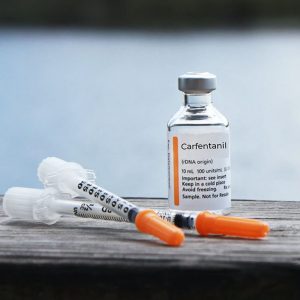
The structural analogues of fentanyl are part of the group of synthetic opioids. The relatively easy synthesis procedure, combined with the availability of the necessary precursors and equipment, has strengthened the product’s position on the illicit market. Moreover, in recent years, there has been a tendency for a sharp increase in the number of deaths related to drug overdose and intolerance.
Composition
The chemical name of carfentanil is the methyl ester of 4-((1-oxopropyl)-phenylamino)-1-(2-phenylethyl)-4-piperidine carboxylic acid. Its structure resembles that of its predecessor, fentanyl. However, unlike it, carfentanil is not intended for therapeutic use in humans.
In the illicit markets that distribute carfentanil, the drug is known as “elephant tranquilizer” or “C.50.” It is the active ingredient in one of the most dangerous street drugs, “gray death,” also containing heroin, fentanyl and another synthetic opioid, U-47700. The American press gave it the expressive name “drop dead”.
Visually, the narcotic substance has the appearance of pellets or pale yellow crystalline powder. Due to its lipophilic properties it quickly penetrates through the blood-brain barrier. It can be detected in whole blood and urine even after death, but this requires specialized diagnostics.
Action
Carfentanil is considered one of the most potent opioid receptor agonists available today. Its main legal use is in veterinary medicine. Just 2 mg of the substance (“Wildnil”) is enough to put an adult elephant to sleep. In the U.S. it is common as a tranquilizer for elk and bears (the same darts shown in American movies), it is also used in farms.
Like its chemical precursors, carfentanil acts on the central nervous system via μ-opioid receptors. After entering the systemic bloodstream, the following effects develop:
analgesia at the tranquilizer level
suppression of the respiratory center
cough suppression
constriction of the pupils
drowsiness
sedation
The analgesic effect is 100 times more effective than fentanyl, 5000 times more effective than heroin and about 10,000 times more effective than morphine. The minimum active dose that has a pharmacological effect on a person is 1 mcg (0.000001 g).

Use in drug addicts
The bioavailability of the drug is very high. It retains pharmacological activity by all possible routes of administration, including oral, intranasal, sub- and cutaneous. Vapor or aerosol inhalation is also suspected to be effective. Studies in dogs have proven loss of consciousness and complete immobility after inhalation of carfentanil vapors within 1 min. Intravenous injections have been associated with death in over 50% of cases.
It is believed that the euphoria (intoxication) of fentanyl analogues is not as strong as that of heroin (EMCDDA, 2015). But the feeling of “coming on” is almost instantaneous. Often the central nervous system depression is so severe that users are unable to move. The total duration of action varies from 30-40 minutes to several hours, which is determined by the composition of the finished product.
Tablets and powders containing various structural analogues of fentanyl are more dangerous to public health than heroin. Often dealers are silent about the true composition of the finished product, making the consumer unable to calculate the appropriate dose, not to mention a host of side effects. Today, carfentanil remains the most potent commercially available opioid in the world that is not under international control.
Formation of addiction
Carfentanil abuse is rare and short-lived. Even a single episode can be the last, given how easy it is to get the dosage wrong. Attempting to prepare a suitable single dose by weighing without precision equipment is risky. Any miscalculation is potentially fatal.
It is most often just one of many components in the finished street product. Even a minuscule dose of the substance can multiply the effects of heroin. This is why addiction usually develops to mixed drugs or opiates in general after only a few episodes of use. The addictive potential has not been formally tested in controlled clinical trials.
Opioid dependence is among the most severe addictions. A persistent psychophysical need to take the drug is formed. Already after a couple of months addicts stop feeling the “positive” effects. Only with systematic use they are able to find their “comfort zone”. Outside of the intake the withdrawal syndrome is pronounced.
Consequences of use
Systematic use of fentanyl analogues leads to tolerance. It has been demonstrated in animal experiments that they are able to cross-receptor substitute morphine. Therefore, opiate addicts perceive carfentanil as a substitute for heroin with similar effects. They are attracted by the cheapness and lower dosage, all the risks recede into the background.
The main side effect of taking opiates is a pronounced depression of the respiratory center. Overdose leads to a stop of its regulation, i.e. to death. Manifestations of acute intoxication are nonspecific: impaired consciousness, pulmonary edema, arrhythmias, multiple organ failure.
The risk of incorrect dose selection is increased when using strong synthetic opioids without observing safety precautions. It should not be forgotten that in addition to the chosen route of administration, carfentanil additionally enters the body with the breath and through the skin. In the U.S. and Canada, law enforcement officers are routinely hospitalized while making seizures of suspicious chemicals.

